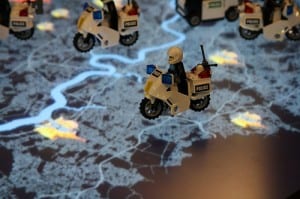Social Physics in the Big City
By Clare S Ryan, on 12 December 2012

CASA’s ENFOLDing group used real data from the
London riots and contagion modelling principles to
create a riot model that could be used to identify
areas of high risk and predict the outcome of
police response.
So what the heck is “social physics” anyway? That’s probably the question that most people who rocked up to Dr Martin Zaltz Austwick’s Lunch Hour Lecture, Social Physics in the Big City, were thinking to themselves.
No offence, but physicists aren’t exactly famed for their social brilliance (as Martin is quick to point out). However, having met Martin before, I was slightly more optimistic.
It turns out that Martin (who describes himself as a social physicist FYI) has some fairly hefty academic forefathers including 19th century French philosopher Auguste Comte (sadly not related to the delicious French cheese) and his contemporary, the mathematician and sociologist Adolphe Quatelet.
These two had the idea of using maths to predict the future of society – an aim they had in common with later thinkers such as Karl Marx (big ideas, less successful when it came to undermining capitalism in the long run) and Isaac Asimov (great science fiction author, less great academic).
“So much for the dead white guy theory of social physics then,” said Martin. Although I couldn’t help but notice that Martin was very much alive.
I digress. Social physics is all about applying mathematical methods to social systems – what you might call quantitative social science. And that is what Martin does as an academic in the UCL Centre for Advanced Spatial Analysis (CASA).
So, where to get the data? Well, we’re kind of swimming in it actually. Oyster cards, traffic data, mobile devices and smart meters (which measure energy use) provide loads of information about how this city, London, ticks.
For example, one of Martin’s colleagues, Jon Reades, used Oyster card data to make an animated map of London showing tube use over the course of a Monday.
This map is the first example of many in Martin’s talk of data visualisation, which is something that CASA is particularly good at.
If you’re a fan of the Guardian’s Datablog, you’ve undoubtedly already seen some of their work, including Martin’s map of Boris Bike use and a recent twitter language map of London.
CASA also draws on the increasing amount of ‘volunteer data’ out there such as information mined from social media (usually twitter) and GPS location mapping. A big project in CASA is ‘tales of things’, where people record the history of objects on a website and then tag the object with a QR code that people can scan using their phones.
On a larger scale, there is the Open Data movement, which tries to make national data public, for example from eGovernance initiatives and Transport for London.
Clearly, this raises question about privacy and the sensitivity of data. Are we happy for academics to look at our tweets? Are we less comfortable with sharing Facebook data?
Slightly reassuringly (for me, at least) it seems clear that people at CASA are not interested in individuals, but looking at patterns across large data sets.
So, once he has all this data, how does Martin manipulate it all to produce amazing visualisations and derive some meaning about cities from it?
Well, very big computers have helped. Data tools running on powerful computer processors have only really been available recently.
Social physicists also use simulations to help understand cities. Basically, these are computer programs that are set loose to interact with each other and a virtual environment. This might be used to simulate how pedestrians move through space.
Having spent so much time looking at vast amounts of data and gleaning meaning from it, CASA staff are very keen to share what they are doing, both to develop their analyses and to have a positive impact on citizens.
One great way that they’ve already done this is by putting together an interactive map of constituency boundary changes in the UK, which people can use to see how border movements affect them.
There’s also the City Dashboard – which draws together multiple sources of data about a city together including weather, traffic, mood, news, pollution levels etc. There’s even a smart phone app that measures the city’s happiness, brilliantly called mappiness. Smiles all round.
And finally – if none of that tickles your fancy – why not try out Pigeon Sim, which let’s you fly around the city using a Google Earth map.
Who says social physicists don’t know how to have fun, eh?
 Close
Close

